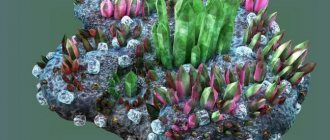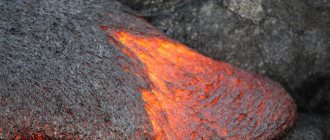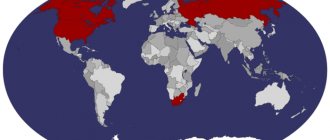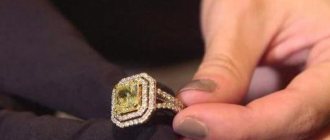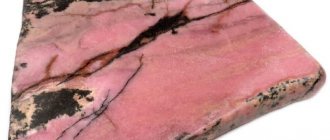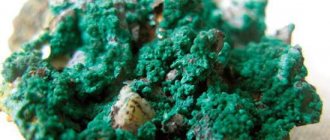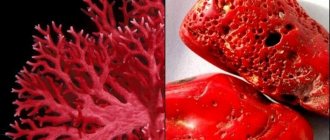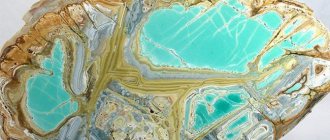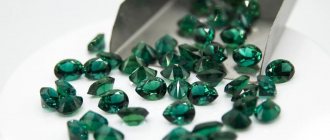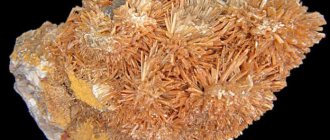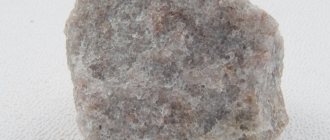In the previous article we looked at general information about what a coral reef is; where the reefs are located; who lives among corals and how to distinguish living coral from dead.
Now let's take a closer look at coral polyps, look at their most common types in the Red Sea and find out what can happen if you accidentally touch corals while snorkeling or scuba diving.
History and origin
Coral is the oldest mineral in the world, taking thousands of years to form. It is formed from spongy microorganisms - polyps, which make up reefs in tropical seas.
Helpful information
In its raw form, coral looks porous, rough, and takes on bizarre shapes. After jewelry processing, it acquires a pronounced smoothness and glass shine.
An ancient Greek legend is associated with the origin of the stone. The hero Perseus cut off the head of the invincible Gorgon Medusa. As he flew over the sea, with her bloody head, drops of blood fell into the water and turned into red corals.
The jewelry, magical and medicinal properties of coral were highly valued by the inhabitants of Ancient Greece, India, and China. The stone was used not only to create beautiful jewelry - it served as a material for making religious attributes. People believed in the ability of coral to protect its owner from temptations and evil spirits. The gem was popular in Medieval Europe and in the modern era.
Today, jewelers value this mineral for its wide variety of shades and ease of processing. Astrologers and psychics note many healing and magical properties of the gem.
Coral rocks
How can we explain the presence of a long strip of hard coral rocks near most of the coral sand islands? Almost every island has a strip of rocks bordering the shore, consisting of long-dead and destroyed corals. Thus, for example, at the island of Heron, a continuous strip of rocky reefs stretches for several hundred yards along the southern shore, approximately equal distances from the upper and lower boundaries of the tidal lagoon. In all likelihood, at one time in place of this strip there was a dense mass of coral several feet thick; At present, transverse and oblique excavations have divided a continuous strip of reefs into several separate large blocks, the bases of which are still connected to each other. The inner slopes of this rocky strip, formed as a result of hardening of coral sand, smoothly connect to the sandy shore of the island. During periods of heavy rain, streams of water fell on the island and, flowing into the sea, carried with them the dissolved sticky mass. Not far from the shore, these sediments sank to the sandy bottom, and at low tide, quickly drying out under the hot rays of the tropical sun, the sticky substance cemented and united individual grains of sand, turning them into durable blocks. After each rainy season, more and more of these stones appeared near the shore, until, over the course of perhaps many decades and centuries, a continuous solid surface several feet thick had formed. But in parallel with this process, rains and waves broke the rocky chain, creating straits and channels of varying widths and depths. Near individual islands, such channels have torn apart the strip of rock in many places, leaving a large number of randomly scattered flat boulders above the surface. Such a picture, for example, can be seen off the coast of Wilson Island (Capricorn group).
Place of Birth
Corals grow in warm seas where the water temperature exceeds 20 degrees. The largest deposits of this mineral are located in the depths of the Caribbean, Mediterranean and Red Seas. Today, large-scale stone mining is carried out:
- in Central American countries;
- Australia;
- India;
- Italy;
- Turkey;
- off the coast of Algeria;
- Tunisia.
The most valuable specimens are found in Taiwan, Japan, and off the Samoan Islands.
Production
Corals are mined both in shallow water (3-4 meters deep) and in deep water (more than 300 meters deep). They are retrieved from the seabed using bottom nets that are lowered and dragged along the seabed. This method is considered barbaric, since such extraction spoils most of the valuable mineral and causes significant harm to the fauna of the seas.
As in ancient times, the profession of coral diver is in demand today. Many such craftsmen hunt along the coasts of the Caribbean Sea. They find shallow coral reefs, dive into the water and break off some of the mineral.
Basic data
Since ancient times, amulets have been made from it, and clothes and interiors have also been decorated. They believed that it had a positive effect on the human condition and was able to protect against illnesses.
In Ukraine and some other countries, coral beads are considered national women's clothing and are an integral part of the entire look. Previously, a large number of beads meant a girl’s high position in society.
Jewelers love coral because it lends itself well to processing and is quite popular among women. It is used to make beads and earrings, as well as bracelets, medallions and pendants. Red, pink and black inserts into jewelry are often found.
Where is it mined?
Corals are mined in any ocean or sea with a water temperature above 21 degrees. Most often - in the Mediterranean Sea, namely near Italy and Tunisia.
The most prized are black corals found in the Red Sea. Their cost differs significantly from other shades.
Dark red and blue corals can be found off the Samoan islands.
Coral grows on the bottom of the ocean or sea in the form of a bush. After it is brought to the surface, it is processed and jewelry is made from it. At the same time, they are sorted by shade, quality, defects and thickness.
Varieties
Many people believe that corals are only red, but this assumption is erroneous.
Main types:
- Foamy. Their peculiarity is that they combine both hard and soft rock.
- Root. Outwardly they resemble a bush with a lot of branches.
- Noble. They are most valued and cost more than others. This is what jewelry is made from.
No matter how surprising it may sound, there are a lot of shades of corals, about 350. The most popular of them got their names:
- Akabar or akkarbar are black stones;
- Fiery – distinguished by a bright bloody hue;
- Arciscuro carbonetto – red;
- Pelle deangelo – pink4
- Akori is a blue mineral that is very rare
- Bianko – white.
Types of coral
More than 2 thousand species of corals are found in nature. They are found in several hundred different shades. The color of a stone depends on its composition, so jewelers use only the main 16 colors of the mineral in their work - the rest are not suitable for processing due to their high fragility.
The main types of corals popular in jewelry:
- Rosso is a blood-red mineral, one of the most expensive specimens.
- Ox's blood is a dark brown stone.
- Akori is a valuable rare species of blue color.
- Akabar (royal coral) is a black jewel listed in the Red Book.
- Angel Skin is a pale pink reef.
- Rosa Vivo - stones of a bright pink hue.
- Secondo color - orange-colored minerals.
- Bianco is the cheapest variety of coral and is distinguished by its white color. Often used to counterfeit more expensive types.
Jewelers prefer to use bright corals to create jewelry. They sort minerals not only by color, but also by other distinctive properties - fragility, width of pores.
Questions/Answers
Information about the sea gift would fill a good book. We have selected a small part of the information. Ask what secrets of the stone you want to know about
